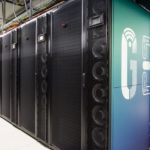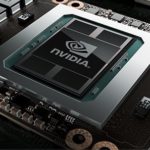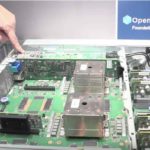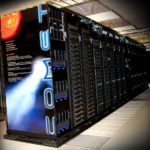Today HPE announced a new supercomputer installation at KU Leuven, a Flemish research university consistently ranked as one of the five most innovative universities in the world. HPE collaborated with KU Leuven to develop and deploy Genius, a new supercomputer built to run artificial intelligence (AI) workloads. The system will be available to both academia and the industry to build applications that drive scientific breakthroughs, economic growth and innovation in Flanders, the northern region of Belgium.
Princeton Team using Deep Learning to develop Fusion Energy
Over at the NVIDIA Blog, Tonie Hansen writes that Princeton researchers are using deep learning to help establish the feasibility of delivering fusion energy in the foreseeable future. “The Princeton team has scaled up the capabilities of its FRNN software using thousands of GPUs to train deep neural networks. After successfully running on 6,000 Tesla K20 GPUs on Oak Ridge National Laboratory’s Titan supercomputer, FRNN has recently demonstrated the ability to scale to 3,000 NVIDIA Tesla P100 GPUs on Japan’s new TSUBAME-3 supercomputer at the Tokyo Institute of Technology.”
NVIDIA Tesla GPUs Come to Oracle Bare Metal Cloud
Over at the NVIDIA Blog, Kristin Bryson writes that the Oracle Bare Metal Cloud now offers Tesla P100 GPUs for technical computing. “The move underscores growing demand for public-cloud access to our GPU computing platform from an increasingly wide set of enterprise users. Oracle’s massive customer base means that a broad range of businesses across many industries will have access to accelerated computing to harness the power of AI, accelerated analytics and high performance computing.”
Purdue Adds New Resource for GPU-accelerated Research Computing
A new computing resource is available for Purdue researchers running applications that can take advantage of GPU accelerators. The system, known as Halstead-GPU, is a newly GPU-equipped portion of Halstead, Purdue’s newest community cluster research supercomputer. Halstead-GPU nodes consist of two 10-core Intel Xeon E5 CPUs per node, 256 GB of RAM, EDR Infiniband interconnects and two NVIDIA Tesla P100 GPUs. The GPU nodes have the same high-speed scratch storage as the main Halstead cluster.
E4 Computer Engineering Demonstrates OpenPOWER Servers at ISC 2017
In this video from ISC 2017, Fabrizio Magugliani from E4 Computer Engineering describes the company’s innovative OP205 OpenPOWER server for HPC applications. “Our newest system, OP205 is our most advanced POWER8-based server designed for high performance computing and big data. It includes coherent accelerator processor interface (CAPI) enabled PCIe slots, and can host two NVIDIA GPUs.”
Dell Builds Bracewell Supercomputer for Bionic Vision Research at CSIRO in Australia
Today CSIRO, Australia’s top science agency, announced deployment of a new Dell EMC supercomputer, kicking off a new generation of research in artificial intelligence. “This new system will provide greater scale and processing power we need to build our computer vision systems by optimization of processing over broader scenarios, represented by much larger sets of images, to help train the software to understand and represent the world. We’ll be able to take our computer vision research to the next level, solving problems through leveraging large scale image data that most labs around the world aren’t able to.” Assoc. Professor Barnes said.
Liquid Cooling for HPC Gains Momentum with Asetek at ISC 2017
“Liquid cooling is becoming the new norm in the face of skyrocketing wattages by CPUs, GPUs and cluster nodes. Asetek cooling solutions are currently provided by OEMs such as Cray, Fujitsu, Format, Penguin. Liquid cooling for NVIDIA P100, Intel Knight’s Landing and Skylake were all on display at Asetek’s booth as well as rack-level options such as InRackCDU and Vertical RackCDU.”
Comet Supercomputer Doubles Down on Nvidia Tesla P100 GPUs
The San Diego Supercomputer Center has been granted a supplemental award from the National Science Foundation to double the number of GPUs on its petascale-level Comet supercomputer. “This expansion is reflective of a wider adoption of GPUs throughout the scientific community, which is being driven in large part by the availability of community-developed applications that have been ported to and optimized for GPUs,” said SDSC Director Michael Norman, who is also the principal investigator for the Comet program.
One Stop Systems Announces SkyScale HPC as a Service
Today One Stop Systems (OSS) annouced the launch of SkyScale, a new company that provides HPC as a Service (HPCaaS). For years OSS has been designing and manufacturing the latest in high performance computing and storage systems. Now customers can lease time on these same systems, saving time and money. OSS systems are the distinguishing factor for SkyScale’s HPCaaS offering. OSS has been the first company to successfully produce a system that can operate sixteen of the latest NVIDIA Tesla GPU accelerators connected to a single server. These systems are employed today in deep learning applications and in a variety of industries including defense and oil and gas.
HPC Workflows Using Containers
“In this talk we will discuss a workflow for building and testing Docker containers and their deployment on an HPC system using Shifter. Docker is widely used by developers as a powerful tool for standardizing the packaging of applications across multiple environments, which greatly eases the porting efforts. On the other hand, Shifter provides a container runtime that has been specifically built to fit the needs of HPC. We will briefly introduce these tools while discussing the advantages of using these technologies to fulfill the needs of specific workflows for HPC, e.g., security, high-performance, portability and parallel scalability.”













